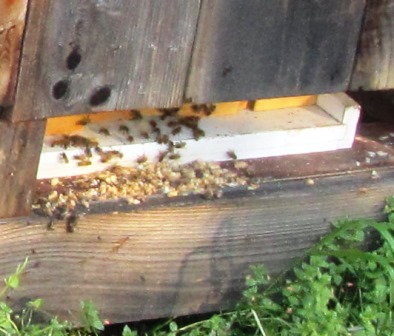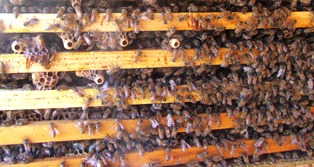Sixty Pounds of Honey, Death of Some Drones, and a New Swarm
I opened my hives this past Sunday with the help of my world-class beekeeper neighbor. We checked on the the condition of eggs, the number of new queens, the growth of baby bees, the presence of mites (none detected), and the amount of honey (lots).
The male bees (the drones) over the last weeks have been engaged in some crazy flight patterns in front of the hive as the mating of the queen takes place. The old queen has done her egg laying and the hives have lots of babies with nurse maids and other worker bees. From the hives comes the clearly audible sound of humming and the fragrant scent of honey.

The drone (male bees) are vital for mating with the queen; after that, they are unnecessary and are eliminated
The drones are not now needed and the workers in the colony are doing away with them. I found a stack of drones at the front door of the hive this morning. Strange sight to see, indeed. But no more so than the many queen houses (formed from honeycomb by the worker bees). These houses are where the new queens are nourished; each contains royal jelly.

The tubular circles are the houses where the baby queens will be cared for by the workers. The houses contain royal jelly for the feeding of the new queens
My neighbor told me to wait three more weeks to take honey, but since I didn’t take any honey during the fall/winter and there were huge stores of it in my hives and coupled with the fact that there’s a plethora of flowers now to provide pollen for the bees, we decided it would be okay to remove some frames. So, I took six frames (weighing roughly ten pounds each) from the hives.
The honey I harvested has a pale lemony color–significant for the wildflowers and almond and fruit tree blossoms from which the bees collected the pollen to make that honey. In the fall, the honey is darker and earthier tasting, thanks to pollen from the star thistle and eucalyptus blooms.
When we had finished with my hives and walked back to my neighbor’s house, we spotted a swarm overhead. We grabbed the pots and wooden spoons and started banging. The bees took refuge in the tall pepper tree and that’s where my neighbor rescued them. In all, it was quite a spectacular Sunday!
A Scrub Jay to Keep Me Company
A Western scrub jay darts into the yard, drops to the ground, and investigates the pottery saucer then pecks at small red berries that have fallen from the giant pepper tree along the back fence. The jay visits almost daily, but the rest of the wildlife seems to have taken cover, maybe because it’s so cold out.
The citrus trees have been covered for a few days with blankets and thick sheeting of black plastic since freezing temperatures are forecast for several days. It’s darn chilly and if the rain comes that is also forecast, we could see a dusting of snow around the top of Mount Diablo.
In early December, I walked around the farmette in shirt sleeves, but today it’s taken three layers of sweaters, two pairs of socks, and long johns under jeans to stay warm. You’d think I was dressing for a visit to Siberia.
This will be a short break. Indoors, I’m working on my own book and editing another one for a friend. My exercise period won’t be long, but at least a walk around the farmette gets blood flowing to my brain, exposes me to the sun for an all important daily dose of vitamin D, and allows me to breathe fresh air. So even if it is only the jay keeping me company, the pleasure is all mine.
 Facebook
Facebook Goodreads
Goodreads LinkedIn
LinkedIn Meera Lester
Meera Lester Twitter
Twitter




